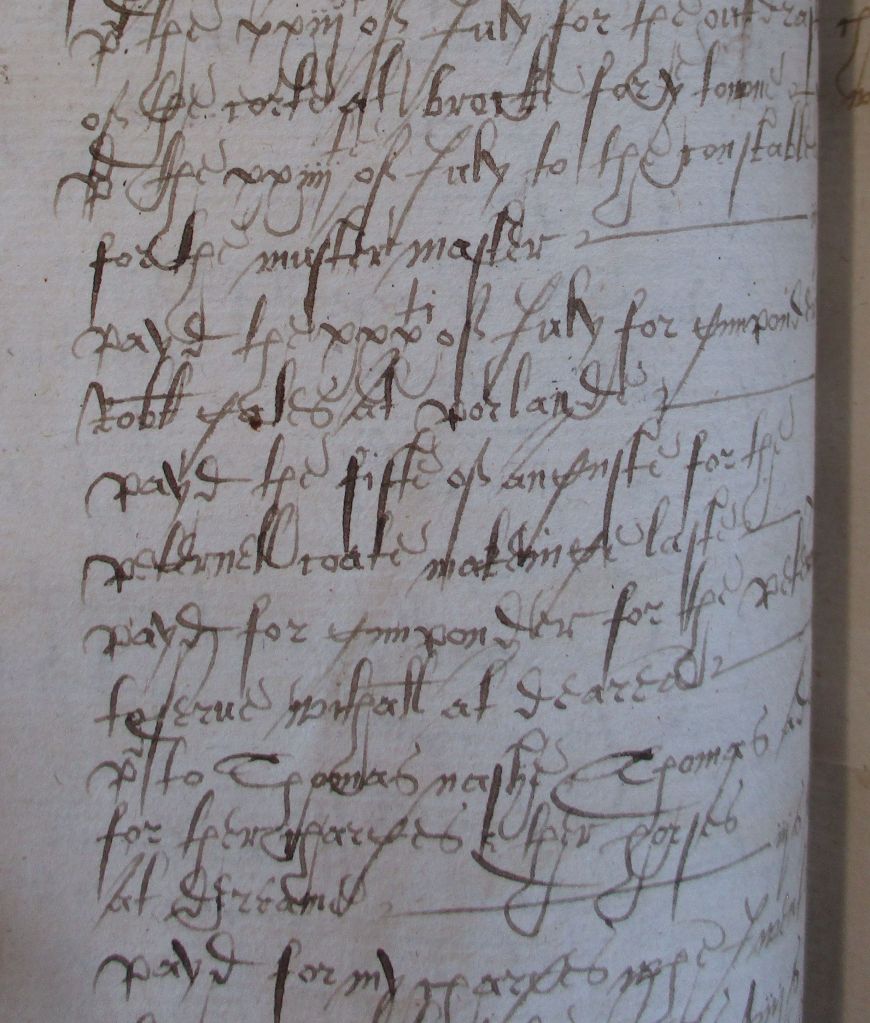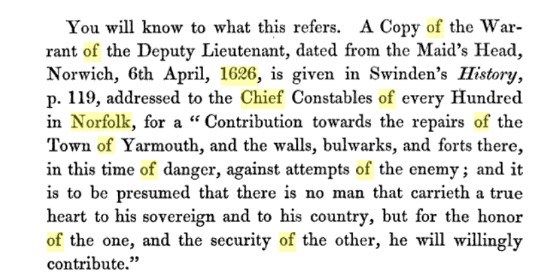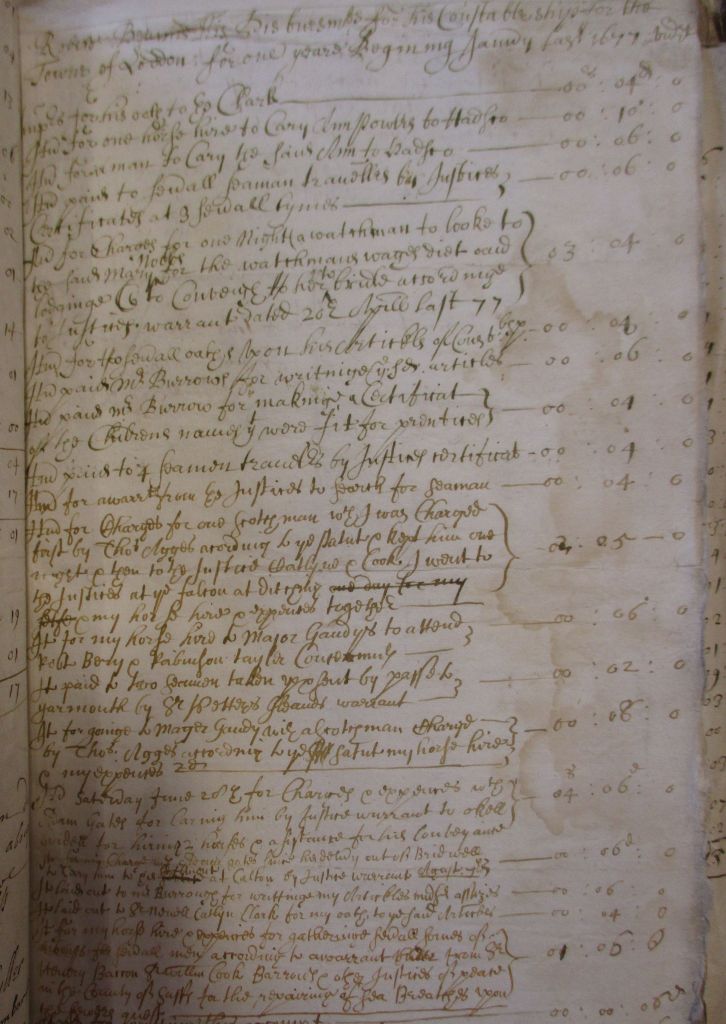The churchwardens accounts give more than just details of how the parish ran its own affairs. They can be invaluable in understanding what was happening in surrounding parishes, other counties and nationwide. Looking into the accounts for Loddon has drawn up some intriguing entries, from paying a subsidy to Suffolk Justices of the Peace to helping with the defence of the nation (PD 595/19). This blog delves into the archives to understand what was happening at the time in order to fully understand each entry.
Each year two men of good character were appointed as Parish Constables (possibly one of the least popular parish duties). It could be time consuming rounding up miscreants, taking them to the Justices and even to the Bridewell. At the end of their year’s duty they submitted their expenses account.
1590s- Payments for maimed soldiers.
One of the delights of transcribing the Churchwardens Accounts is the vagaries of the spelling. A word that appears in many of the years is soldiers, but when I first started looking at the document I was confused by sogers, solgurs, souldyers, souldgers and other variations. The entries often related to collections for “maimed soldiers” by the County Chief Constable. The provision for soldiers released from service, and particularly those injured was poor. Many became vagrants begging and stealing. Different monarchs attempted to solve the problem by encouraging local charitable provision and later taxation. In 1602the Loddon Churchwardens paid 4s 4d towards these soldiers. By 1626 image 5516we find a bulk collection of 11s 11d ‘for halfe a yere due at midsum 1626 for the Marshallseas Kings Bench (courts down in London) & prisoners in the Castell & maimed souldgers’.

Loddon also had to provide men and arms for the militia.In the 1590s they paid 19s to the constables for setting forth of soldiers, and 4s 1d to setting forth certain footmen to Ireland.
1600s- Muster at Dereham
In 1599 there seems to have been a muster at Dereham, and Loddon provided powder for the Petronel (a long barrelled gun. It was fired with the barrel supported on a stick and the butt against the chest), making the Petronel coat (a thick padded jacket for protection) good, and the cost of having the men at the muster.

Transcript from 1599
| Pd the xxiiij of July to the Constable for the muster master |
| Payd the fifte of auguste for the peternel coate making last |
| Payd for gimponder for the peteteserne withal at deared |
| P to Thomas nashe & Thomas Ad For ther charges & ther horses at deream |
Transcript from 1601
| Firste for the settinge forthe of 4 soldeyers 56s |
| for the mayned soldyers 3s 3d |
| for the setting forthe of the petrenells 2s |
1626- Defence work at Great Yarmouth
In 1626 Loddon was once again paying for defence works in other parts of the county. Charles I had been crowned king in February and dissolved Parliament in July. The following year England unsuccessfully invaded La Rochelle in support of the Huguenots. Perhaps it was in preparation for this and other battles that the authorities decided to start strengthening its defences around the east coast.
According to Norfolk Heritage Explorer (add the http://www.heritage.norfolk.gov.uk/ link to the words Norfolk Heritage Explorer) the walls of Great Yarmouth were not strong enough for canons to be mounted upon them. Therefore, mounds or Mounts were built as canon emplacements. The first was built in 1569, which became the New Mount in 1588. The second, called the South Mount was built in in 1570. These defences seem not to have been very effective, therefore, a further mount, known as the Main Guard was built in 1626. This was partly put down to a response to raids by pirates. The Chief Constables of each Hundred (the county was divided into 36 hundreds (add link to the words 36 hundreds – https://www.archives.norfolk.gov.uk/help-with-your-research/using-the-archives/parish-maps) which were areas of land. The term used until the 19th century) were asked for a payment. As part of this the good people of Loddon were required to contribute to its construction. In the 1626 Churchwardens Accounts of William Belson & Robert Davey we find the entry for the payment from Loddon.

Transcript from 1626
| laid out to Kempe the Cunstable upon a warrant that Cam from the Leftenant for the making of mounts at yarmouth £1 4d 0s |
Norfolk Archaeology, Volume 2 (1847) contains an article by James Copeman, which confirms what was happening in the county at the time.

Eventually the threat of pirates and retaliatory battles subsided, and the Main Guard was finally levelled in the 1970s.
1677- Sea breaches
By the 1670s it was clear that it wasn’t just defence from pirates but also defence from the sea that was costing the people of Loddon money. In 1677 Robert Beames submitted his account.

It may be possible to find out more about the removal of Ann, or the reasons for Mary Nobbs stay in the Bridewell (Norwich) or Adam Gates stay in the Acle Bridewell, using other sources. However, the last entry was a puzzle. Why should several men be paying a subsidy (a tax) to the Suffolk Justices of the Peace? Finally, after a lot of research we discovered reports of a 1660 sea breach between Lowestoft & Kirkley. It transpired that Loddon fell into the area of the Waveney Flood plain and therefore was liable to contribute to the Sea Wall repairs; in 1660 the sum of £10 11s 6d was to be collected from Loddon from a total tax of £573.
It goes to show that using one simple document can tell you a lot more about the events outside of the parish for which it was created.
Written by Elvie Herd














A very interesting piece, particularly the reference to the sea breach. I would like to add further details of this event into my Raging Sea database, could you help with other references please Elvie?
David Stannard
LikeLike
Hi David, Thanks for your comment. I will forward your question on to Elvie and will let you know her response.
LikeLike
Hi David, Elvie has provided lots of information for you, so I have sent it to you in an email.
LikeLike